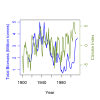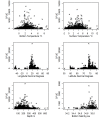Historical Arctic Logbooks Provide Insights into Past Diets and Climatic Responses of Cod
- PMID: 26331271
- PMCID: PMC4557987
- DOI: 10.1371/journal.pone.0135418
Historical Arctic Logbooks Provide Insights into Past Diets and Climatic Responses of Cod
Abstract
Gadus morhua (Atlantic cod) stocks in the Barents Sea are currently at levels not seen since the 1950s. Causes for the population increase last century, and understanding of whether such large numbers will be maintained in the future, are unclear. To explore this, we digitised and interrogated historical cod catch and diet datasets from the Barents Sea. Seventeen years of catch data and 12 years of prey data spanning 1930-1959 cover unexplored spatial and temporal ranges, and importantly capture the end of a previous warm period, when temperatures were similar to those currently being experienced. This study aimed to evaluate cod catch per unit effort and prey frequency in relation to spatial, temporal and environmental variables. There was substantial spatio-temporal heterogeneity in catches through the time series. The highest catches were generally in the 1930s and 1940s, although at some localities more cod were recorded late in the 1950s. Generalized Additive Models showed that environmental, spatial and temporal variables are all valuable descriptors of cod catches, with the highest occurring from 15-45°E longitude and 73-77°N latitude, at bottom temperatures between 2 and 4°C and at depths between 150 and 250 m. Cod diets were highly variable during the study period, with frequent changes in the relative frequencies of different prey species, particularly Mallotus villosus (capelin). Environmental variables were particularly good at describing the importance of capelin and Clupea harengus (herring) in the diet. These new analyses support existing knowledge about how the ecology of the region is controlled by climatic variability. When viewed in combination with more recent data, these historical relationships will be valuable in forecasting the future of Barents Sea fisheries, and in understanding how environments and ecosystems may respond.
Conflict of interest statement
Figures





References
-
- Beaugrand G, Reid PC. Long-term changes in phytoplankton, zooplankton and salmon linked to climate. Global Change Biology. 2003; 9: 801–817.
-
- Stempniewicz L, Blachowiak-Samolyk K, Weslawski JM. Impact of climate change on zooplankton communities, seabird populations and arctic terrestrial ecosystem—A scenario. Deep-Sea Research Part II. 2007; 54: 2934–2945.
-
- Engelhard GH, Ellis JR, Payne MR, ter Hofstede R, Pinnegar JK.Ecotypes as a concept for exploring responses to climate change in fish assemblages. ICES Journal of Marine Science. 2011a; 68: 580–591.
-
- Simpson SD, Jennings S, Blanchard JL, Schön P-J, Johnson MP, Sims DW et al. Continental shelf-wide response of a fish assemblage to rapid warming of the sea. Current Biology. 2011; 21: 1565–1570. - PubMed
-
- Yamanouchi T. Early 20th century warming in the Arctic: a review. Polar Science. 2011; 5: 53–71.
Publication types
MeSH terms
LinkOut - more resources
Full Text Sources
Other Literature Sources
Miscellaneous

